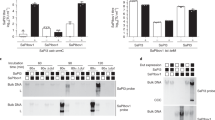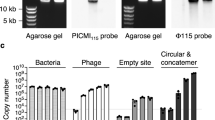Key Points
-
Staphylococcus aureus pathogenicity islands (SaPIs) are highly mobile phage-related mobile genetic elements in staphylococci. Elements similar to SaPIs have been detected in related Gram-positive bacteria, prompting a name change to phage-related chromosomal islands (PRCIs).
-
PRCIs are normally quiescent until they are induced by a helper phage that inactivates the repressor Stl. The mechanism of induction seems to vary between Stl molecules and requires helper phages specific for the SaPI.
-
SaPIs are packaged by capsid proteins encoded by the helper phage, but helper phage DNA is excluded. Therefore, SaPIs can hijack the helper phage to mediate their own spread.
-
In some cases autonomous replication of the SaPIs takes place. There are several proposed models for replication mechanisms in these SaPIs.
-
Recently, high-frequency transfer of SaPIs to Listeria monocytogenes was demonstrated, suggesting that silent phage-mediated intergeneric transfer may be an important but, to date, unrecognized mode of horizontal gene transfer among bacteria.
Abstract
The phage-related chromosomal islands (PRCIs) were first identified in Staphylococcus aureus as highly mobile, superantigen-encoding genetic elements known as the S. aureus pathogenicity islands (SaPIs). These elements are characterized by a specific set of phage-related functions that enable them to use the phage reproduction cycle for their own transduction and inhibit phage reproduction in the process. SaPIs produce many phage-like infectious particles; their streptococcal counterparts have a role in gene regulation but may not be infectious. These elements therefore represent phage satellites or parasites, not defective phages. In this Review, we discuss the shared genetic content of PRCIs, their life cycle and their ability to be transferred across large phylogenetic distances.
This is a preview of subscription content, access via your institution
Access options
Subscribe to this journal
Receive 12 print issues and online access
$209.00 per year
only $17.42 per issue
Buy this article
- Purchase on Springer Link
- Instant access to full article PDF
Prices may be subject to local taxes which are calculated during checkout



Similar content being viewed by others
Change history
16 July 2010
In this article, the middle initial of one of the authors was omitted in the printed version. The author's full name is Gail E. Christie.
References
Gogarten, J. P., Doolittle, W. F. & Lawrence, J. G. Prokaryotic evolution in light of gene transfer. Mol. Biol. Evol. 19, 2226–2238 (2002).
Katayama, Y., Ito, T. & Hiramatsu, K. A new class of genetic element, staphylococcus cassette chromosome mec, encodes methicillin resistance in Staphylococcus aureus. Antimicrob. Agents Chemother. 44, 1549–1555 (2000).
Gillet, Y. et al. Association between Staphylococcus aureus strains carrying gene for Panton-Valentine leukocidin and highly lethal necrotising pneumonia in young immunocompetent patients. Lancet 359, 753–759 (2002).
Vojtov, N., Ross, H. F. & Novick, R. P. Global repression of exotoxin synthesis by staphylococcal superantigens. Proc. Natl Acad. Sci. USA 99, 10102–10107 (2002).
Novick, R. P. Mobile genetic elements and bacterial toxinoses: the superantigen-encoding pathogenicity islands of Staphylococcus aureus. Plasmid 49, 93–105 (2003).
Lindsay, J. A., Ruzin, A., Ross, H. F., Kurepina, N. & Novick, R. P. The gene for toxic shock toxin is carried by a family of mobile pathogenicity islands in Staphylococcus aureus. Mol. Microbiol. 29, 527–543 (1998).
Subedi, A., Ubeda, C., Adhikari, R. P., Penades, J. R. & Novick, R. P. Sequence analysis reveals genetic exchanges and intraspecific spread of SaPI2, a pathogenicity island involved in menstrual toxic shock. Microbiology 153, 3235–3245 (2007).
Takeuchi, F. et al. Whole-genome sequencing of Staphylococcus haemolyticus uncovers the extreme plasticity of its genome and the evolution of human-colonizing staphylococcal species. J. Bacteriol. 187, 7292–7308 (2005).
Kuroda, M. et al. Whole genome sequence of Staphylococcus saprophyticus reveals the pathogenesis of uncomplicated urinary tract infection. Proc. Natl Acad. Sci. USA 102, 13272–13277 (2005).
Scott, J., Thompson-Mayberry, P., Lahmamsi, S., King, C. J. & McShan, W. M. Phage-associated mutator phenotype in group A streptococcus. J. Bacteriol. 190, 6290–6301 (2008).
Madhusoodanan, J. et al. in Abstracts of the 107th General Meeting of the American Society for Microbiology (ASM, Washington DC, 2007).
Baba, T. et al. Genome and virulence determinants of high virulence community-acquired MRSA. Lancet 359, 1819–1827 (2002).
Ubeda, C., Barry, P., Novick, R. P. & Penades, J. R. Characterization of mutations defining SaPI functions and enabling autonomous replication in the absence of helper phage. Mol. Microbiol. 67, 493–503 (2008).
Ziegelin, G., Linderoth, N. A., Calendar, R. & Lanka, E. Domain structure of phage P4 α protein deduced by mutational analysis. J. Bacteriol. 177, 4333–4341 (1995).
Ubeda, C. et al. Specificity of staphylococcal phage and SaPI DNA packaging as revealed by integrase and terminase mutations. Mol. Microbiol. 72, 98–108 (2009).
Ubeda, C. et al. SaPI operon I is required for SaPI packaging and is controlled by LexA. Mol. Microbiol 65, 41–50 (2007).
Tormo, M. A. et al. Staphylococcus aureus pathogenicity island DNA is packaged in particles composed of phage proteins. J. Bacteriol. 190, 2434–2440 (2008).
Barry, P. in Microbiology (New York Univ. Press, New York, 2006).
Campbell, A. M. in Modern Prespectives in Biology (eds Halvorson, H. O., Roman, H. L. & Bell, E.) (Harper & Row, New York, 1969).
Ruzin, A., Lindsay, J. & Novick, R. P. Molecular genetics of SaPI1 – a mobile pathogenicity island in Staphylococcus aureus. Mol. Microbiol. 41, 365–377 (2001).
Novick, R. P. & Subedi, A. The SaPIs: mobile pathogenicity islands of Staphylococcus. Chem. Immunol. Allergy 93, 42–57 (2007).
Chen, J. & Novick, R. P. Phage-mediated intergeneric transfer of toxin genes. Science 323, 139–141 (2009).
Maiques, E. et al. Role of staphylococcal phage and SaPI integrase in intra- and interspecies SaPI transfer. J. Bacteriol. 189, 5608–5616 (2007).
Tormo-Mas, M. A. et al. Moonlighting bacteriophage proteins derepress staphylococcal pathogenicity islands. Nature 465, 779–782 (2010).
Chan, S. et al. Crystal structure of the Mycobacterium tuberculosis dUTPase: insights into the catalytic mechanism. J. Mol. Biol. 341, 503–517 (2004).
Ubeda, C. et al. Sip, an integrase protein with excision, circularization and integration activities, defines a new family of mobile Staphylococcus aureus pathogenicity islands. Mol. Microbiol. 49, 193–210 (2003).
Ubeda, C., Penades, J. R. & Novick, R. P. A pathogenicity island replicon in Staphylococcus aureus replicates as an unstable plasmid. Proc. Natl Acad. Sci. USA 104, 14182–14188 (2007).
Tallent, S. M., Langston, T. B., Moran, R. G. & Christie, G. E. Transducing particles of Staphylococcus aureus pathogenicity island SaPI1 are comprised of helper phage-encoded proteins. J. Bacteriol. 189, 7520–7524 (2007).
Poliakov, A. et al. Capsid size determination by Staphylococcus aureus pathogenicity island SaPI1 involves specific incorporation of SaPI1 proteins into procapsids. J. Mol. Biol. 380, 465–475 (2008).
Gill, J. J. et al. Efficacy and pharmacokinetics of bacteriophage therapy in treatment of subclinical Staphylococcus aureus mastitis in lactating dairy cattle. Antimicrob. Agents Chemother. 50, 2912–2918 (2006).
Arnold, H. P. et al. The genetic element pSSVx of the extremely thermophilic crenarchaeon Sulfolobus is a hybrid between a plasmid and a virus. Mol. Microbiol. 34, 217–226 (1999).
Schlievert, P. M., Shands, K. N., Dan, B. B., Schmid, G. P. & Nishimura, R. D. Identification and characterization of an exotoxin from Staphylococcus aureus associated with toxic-shock syndrome. J. Infect. Dis. 143, 509–516 (1981).
Altemeier, W. A. et al. Staphylococcus aureus associated with toxic shock syndrome. Ann. Int. Med. 96, 978–982 (1982).
Kreiswirth, B. N., Projan, S. J., Schlievert, P. M. & Novick, R. P. Toxic shock syndrome toxin 1 is encoded by a variable genetic element. Rev. Infect. Dis. 11 (Suppl. 1), S83–S88 (1989).
Chu, M. C. et al. Association of toxic shock toxin-1 determinant with a heterologous insertion at multiple loci in the Staphylococcus aureus chromosome. Infect. Immun. 56, 2702–2708 (1988).
Kuroda, M. et al. Whole genome sequencing of methicillin-resistant Staphylococcus aureus. Lancet 357, 1225–1240 (2001).
Lindsay, J. A. & Holden, M. T. Staphylococcus aureus: superbug, super genome? Trends Microbiol. 12, 378–385 (2004).
O'Neill, A. J., Larsen, A. R., Skov, R., Henriksen, A. S. & Chopra, I. Characterization of the epidemic European fusidic acid-resistant impetigo clone of Staphylococcus aureus. J. Clin. Microbiol. 45, 1505–1510 (2007).
Holden, M. T. et al. Complete genomes of two clinical Staphylococcus aureus strains: evidence for the rapid evolution of virulence and drug resistance. Proc. Natl Acad. Sci. USA 101, 9786–9791 (2004).
Kwan, T., Liu, J., DuBow, M., Gros, P. & Pelletier, J. The complete genomes and proteomes of 27 Staphylococcus aureus bacteriophages. Proc. Natl Acad. Sci. USA 102, 5174–5179 (2005).
Fitzgerald, J. R. et al. Characterization of a putative pathogenicity island from bovine Staphylococcus aureus encoding multiple superantigens. J. Bacteriol. 183, 63–70 (2001).
Novick, R. P., Schlievert, P. & Ruzin, A. Pathogenicity and resistance islands of staphylococci. Microbes Infect. 3, 585–594 (2001).
Diep, B. A. et al. The complete genome sequence of USA300, an epidemic community-acquired methicillin-resistant Staphylococcus aureus strain. Lancet 367, 731–739 (2006).
Acknowledgements
We acknowledge, with gratitude, the scientific and intellectual contributions of the many members of our respective laboratories.
Author information
Authors and Affiliations
Corresponding author
Ethics declarations
Competing interests
The authors declare no competing financial interests.
Supplementary information
41579_2010_BFnrmicro2393_MOESM7_ESM.pdf
Supplementary information S3 (table) | Secondary SaPI attS sites in Staphylococcus aureus and Listeria monocytogenes (PDF 240 kb)
Related links
Related links
DATABASES
Entrez Genome
Entrez Genome Project
GenBank
FURTHER INFORMATION
Glossary
- Prophage
-
A quiescent form of a bacteriophage (usually inserted into the chromosome of its host), in which the lytic functions of the phage are repressed.
- Iteron
-
One member of a set of short repeated DNA sequences that are located at a bacterial origin of replication and are required for the initiation of replication.
- SOS response
-
A global stress response to DNA-damaging agents such as ultraviolet light or mitomycin C.
- Campbell mechanism
-
A recombinational mechanism for the insertion of a genetic element, such as a phage genome or a plasmid, into the bacterial chromosome, involving circularization of the element followed by a single crossover with a chromosomal target site.
- Lysogen
-
A bacterium containing an inducible prophage.
Rights and permissions
About this article
Cite this article
Novick, R., Christie, G. & Penadés, J. The phage-related chromosomal islands of Gram-positive bacteria. Nat Rev Microbiol 8, 541–551 (2010). https://doi.org/10.1038/nrmicro2393
Issue Date:
DOI: https://doi.org/10.1038/nrmicro2393
This article is cited by
-
Investigation into the prevalence of enterotoxin genes and genetic background of Staphylococcus aureus isolates from retain foods in Hangzhou, China
BMC Microbiology (2023)
-
Conjugative transfer of streptococcal prophages harboring antibiotic resistance and virulence genes
The ISME Journal (2023)
-
Staphylococcal phages and pathogenicity islands drive plasmid evolution
Nature Communications (2021)
-
A regulatory cascade controls Staphylococcus aureus pathogenicity island activation
Nature Microbiology (2021)
-
Bacterial chromosomal mobility via lateral transduction exceeds that of classical mobile genetic elements
Nature Communications (2021)



